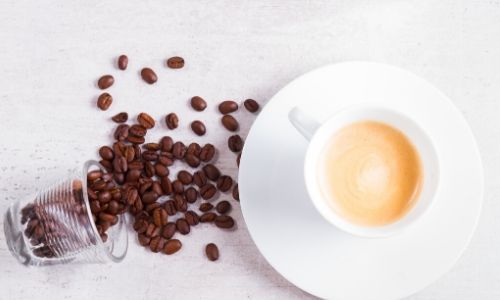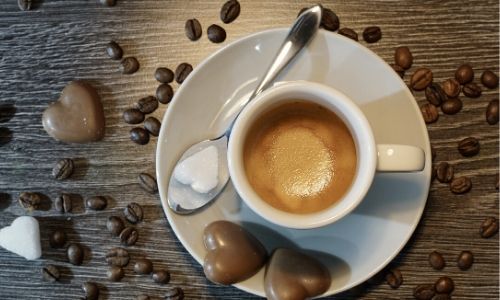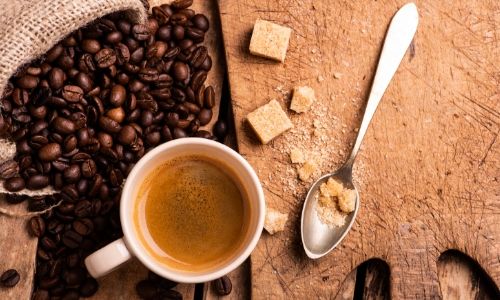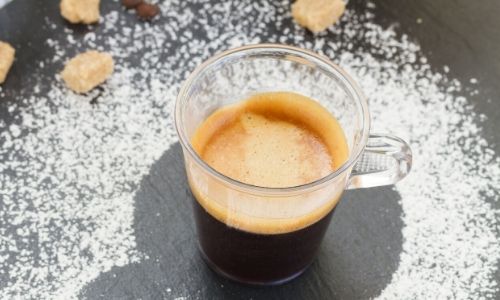Looking for the best espresso beans out there ?
There's a few things that go into making espresso beans espresso beans, and using the right coffee for your espresso shot can really amp it up.
This is what we'll be covering today: how to pick the best coffee (or coffee beans) for espresso brews, so buckle up and enjoy !
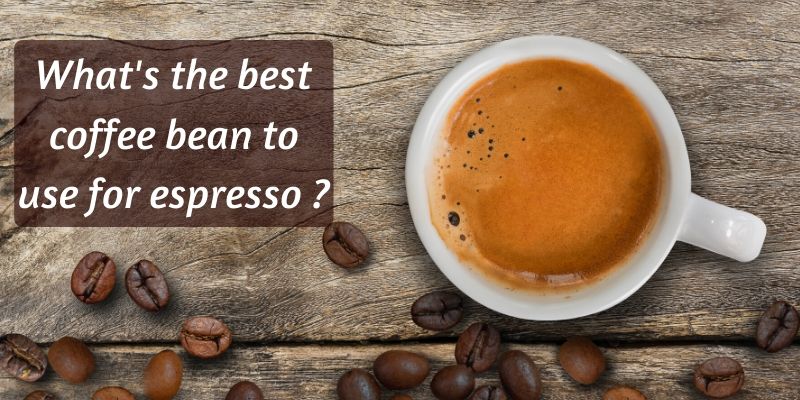
Table of Contents
So what is the best espresso bean ?
The best espresso bean will vary from person to person.
Each person has their own preference, but there also seems to be a baseline most folks prefer.
If we take a look at what most people order, and what is most sold, and what coffee shops offer the most, it comes down to one thing. Medium or medium-dark roast coffee, and it's often not 100% Arabica.
That has a little to do with what part of the world you're from, but also with the best subjective taste.
It turns out espresso really needs that bump in intensity that Robusta can bring, and we'll get into that in a bit.
Another thing to note is that it really matters what you're going to use your espresso for. If you plan to use it as a base for one of the many espresso-based drinks, then you'll need a strong flavor.
We'll get into that in a little bit as well, but first we'll talk a little about the difference between espresso beans and coffee beans.
Espresso beans or regular coffee beans ?
Well, to be perfectly honest there's really not much of a difference between espresso beans and coffee beans.
To better understand this, let's talk a little about what each of them would mean.
First, an espresso bean would be what you would use to make an espresso. Pretty straight-forward. But what makes it an espresso bean, and not a French press bean, or Moka pot bean ?
Nothing, really.
You see, most often espresso beans are just simple coffee beans that have some specific roasting parameters.
Meaning they're meant to be roasted to a certain degree (usually medium-dark or dark), and are most often Arabica beans mixed with a few Robusta beans.
Regular coffee beans can be made with the same specs as espresso beans. Or they can be light roast, pure Arabica, pure Robusta, or any combination you can think of.
Espresso beans is just the name the coffee industry has given to those beans that have been processed according to a specific 'recipe'.
So you can totally use espresso beans in other coffee makers, like Moka for example, or drip-filter. You just need to take into account that it's usually a dark roast and will come out very strong.
If you were to use just any coffee bean - say, a light roasted Arabica - it's be a bit of a waste. You can't get the full range of flavor from those delicate beans when brewed in an espresso machine.
Espresso machines brew quick, strong coffee and using light roast would be a waste. I'm sure there's folks out there who'd say I'm wrong, but try the same beans in a French press and you get a much better flavor.
Back to espresso beans, and what you need to look for.
Espresso needs medium-dark or dark roast
As we were discussing before, espresso is almost always a dark roast, or at least a little darker than medium.
Why is this ? Well, it has to do with 4 things:
- Darker roasts have a darker, stronger flavor
- Lighter roasts don't translate their flavor very well in espresso
- It's easier to roast dark than to stop at medium
- People have come to expect it
The darker the roast, the more espresso-like your coffee will be. To a fault, that is.
Too dark a roast can really just taste like burnt coffee, and there's nothing good there.
You can tell your espresso beans are dark roasted when they have a sheen to them. Coffee oils rise to the surface of the beans and they look like they're coated in laquer.
Darker roasts have a a straight-up shine about them.
As for why people have come to expect dark roasts, it has to do with how espresso has always been served - as a dark roast brew.
So, people have come to know that as the flavor profile of espresso, and they is what they look for when buying espresso.
If you were to use a lighter roast bean, you would need a much more delicate brewing process. You need to remember that espresso is quick, rough, and only works if you've got a small surface area to work with.
This means using very finely ground coffee. This leads to lots of caffeine being extracted, and the flavor comes second.
Whereas for light roast coffee, you'd need a more delicate brewing process, that has a longer extraction time. You'd also fare better with medium ground coffee, if not coarse ground.
So in short, you'll need a dark or medium-dark roast coffee for a regular shot of espresso. It's what's always been done, and it's the way espresso machines work.
The bean type is more important than the origin
This is the second part that you need to really think about. Or at least really understand before you make your decision on which espresso beans to buy.
The truth is, it doesn't matter where your coffee is from when we're dealing with espresso.
At least, it doesn't matter as much as it does with other brewing methods where you really want to taste the specific notes of your brew.
With espresso, you won't really notice it.
So, you now you need to think of what you'd like to do with your espresso.
By this I mean if you're going to mix it with milk, sugar, flavorings, and any other ingredient that may change the final taste of the drink. Because if you are, you'll need a strong espresso.
If you'd rather enjoy your espresso as-is, maybe have it as an espresso macchiato if you're feeling adventurous that day, then you can go ahead and get a 100% Arabica bean.
Let's talk a little about each version, since this will define your choice.
Strong espresso: aim for a 80/20 Arabica and Robusta blend
The best crema comes from a little Robusta thrown into the mix.
If you're thinking this doesn't matter, then you're overlooking the importance of crema when making lattes cappuccinos, flat whites and basically anything that requires foamed milk to mix with crema.
The crema needs to mix into the milk to form the layers of the drink, and to get the latte art everyone takes those pics of. More crema means easier art.
Also, the little bit of Robusta present in the blend will contribute additional flavor and caffeine.
On average, Robusta beans have almost double the caffeine compared to Arabica, and this can really help the weary traveler looking for a pick-me-up in their espresso.
Another difference between the two is that Arabica is the milder, more flavorful bean. In an espresso that can be a little disappointing, so adding a touch of Robusta will really provide some depth to the espresso shot.
Exactly how much Arabica to Robusta is up to your preferences. I've had blends with a 70/30 Arabica Robusta blend and it was almost too much, with just milk and no sugar.
Add a bit of sugar and little more milk - like you would for a cappuccino or latte - and it was damn good.
Again, take a look at what you generally like to do with your espresso, or what you usually order from the coffee shop.
If it's extra sugary and milky, then you'd need quite a bit of Robusta.
The more flavors you add, the more Robusta you need in order for the coffee flavor to cut through all that.
If you're taking your espresso black, it can be 100% Arabica
How about the folks that love their espresso black ?
Well, this is where having pure Arabica is going to be a-okay. There isn't any extra strength you need from your espresso, because you don't need it to do anything.
Just be an espresso, crema and all. No sugar or milk, just the espresso.
If you do add a splash of milk or a dash of sugar, using 100% Arabica is still okay because you're not toning down the coffee flavor too much.
That being said, you still need your coffee medium-dark or dark.
One thing you'll notice if you ever have a cup of espresso with a cup or regular coffee, espresso has way more body and texture to it.
This texture is very much enhanced and created by the darker roast that makes coffee dust very possible, aside from the coffee being ground very finely.
Now you know pretty much everything you needed to know about choosing espresso beans for your home brewing experience.
But there's still a few things you can do to really amp up your espresso experience, in your own home.
Tips on improving your espresso experience at home
Once the coffee beans are roasted, there's not much you can do expect look at the ingredient list and pick according to your preferences.
A few things are still up to you though, or they can be up to you, if you know where to look.
Always, always get fresh roast coffee
Most coffee packs have a 'roasted on' date. there is no real 'best by' date, since coffee itself doesn't expire the way bread or milk does.
However it can and does lose aroma, over time.
Coffee companies usually provide sturdy packaging, and the aroma is mostly saved but it can't last for years and years.
For example a coffee bean roasted in December 1st 2019 wouldn't be all that fresh all the way in December 2022, even with the fancy packaging.
But if you buy and use it by, say February 2019, or even August, it'd still be good.
Once you open the packaging, the flavor starts to wear off quick and you really need to store your coffee beans in a good place.
So always, always check the roasted on date, and get the freshest possible one.
Always grind the beans yourself
Another point, once the beans are roasted the flavor starts to wear off, but gradually.
However they start to get stale the moment you grind them. Which is why pre-ground coffee can be quite flat sometimes.
The best workaround is to get whole, roasted beans and grind them at home, right before you make you espresso.
This is going to ensure a real fresh espresso. You'll feel it in the flavor, and you'll definitely notice a difference in crema.
Conclusion
The best espresso beans are the ones in your soul.
Just kidding, it's a medium-dark or dark Arabica/Robusta mix. Easy with the Robusta or you might get too strong a shot of espresso.
Although if that happens, you'd get yourself an extra large latte that can take all the sugar and flavorings you can throw at it.
If you want to know more about coffee or tea, feel free to check the related articles below. Who knows what else you might find ?

